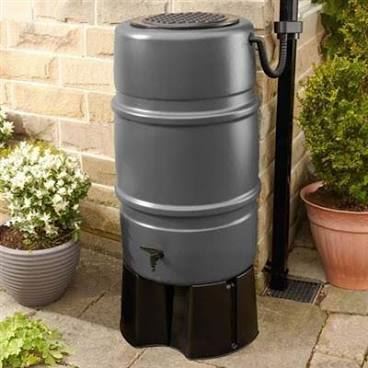|
|
Water butts - a win-win option
This summer we have had an extended period of hot weather, but also periods of very heavy rain. Have you thought of installing a water butt in your garden to help cope with these situations - or maybe you have one already?
A water butt is essentially a large container used to capture and store rainwater. When attached to a drainpipe, the water butt collects the rainwater that lands on the roof of your house for you to use later. Water butts are a boon in dry weather but can also help to slow the flow of rainwater into the river in times of heavy and prolonged rain. In fact, there are so many good reasons in favour of installing a water butt, it has to be a win-win option!
| Harcostar 227 litre water buttThere are many other examples in different shapes and sizes on the web.If possible, attach the butt to the drainpipe that drains from the largest area of your roof. |
Saves water, energy and money
A typical water butt can store around 200 litres of water. It has been estimated that, if every household in the UK got a standard water butt, this would save around 30 000 million litres of water each summer. If your water is metered, this will save on your bill. Treating water to drinkable standards and pumping it to households is energy intensive. Why waste this expensive water on your garden?
In times of dry weather
A water butt is a convenient source of water for the garden in hot dry weather, especially if there is a hosepipe ban. In addition, rainwater is better for plants than chemically treated drinking water from the tap.
Slowing the flow to reduce flood risks and discharge of sewage.
The rainwater that falls on your house and garden joins wastewater in the combined sewer. When the combined sewers are full to capacity during heavy rainfall, they are discharged into the river. You are probably aware of the work of the Ilkley Clean River Group in monitoring and publicising the sewage discharge that has occurred in the River Wharfe as a result.
One way that you can help to slow the flow of excessive rainwater- to reduce the risk of flooding from the River Wharfe and also to prevent the discharge of sewage - is to make your water butt into a sort of 'mini leaky dam'. In the winter, leave the tap open slightly so that the water drains away slowly into a soft area, such as a flower bed. Even better, you can add a tap partway up your water butt, which you can leave open or closed depending on the conditions. When open, the lower half of the butt will store water, but the higher tap will slowly release water. In dry conditions, you can shut the extra tap and use the whole butt to store water - but remember to open it if heavy rain is predicted!
For a second tap you will need:
- a tap with a rubber washer and a plastic nut (from hardware shops or garden centres)
- a drill
- a hole saw or speed bit the same diameter as the pipe to the tap
- PTFE tape.
To fit the tap:
- drill a hole about halfway up the water butt using the holesaw or the speedbit (if using the speedbit you'll get a better result with the drill running at low speed)
- put the washer onto the tap threads using the PTFE tape to form a good seal
- push the tap through the hole in the butt
- attach the plastic nut to the tap threads on the inside of the water butt.
| Water butt with a second tap fitted Image from the 'Slowtheflow' website, see below. |
You can find more information at:
http://slowtheflow.net/retrofitting-water-butts
and
https://waterwise.org.uk/wp-content/uploads/2019/09/Rainwater-butts.doc.pdf
The Ilkley Clean River Group web pages on Facebook give background information on the current situation in Ilkley and progress of their campaign.
Select or click here for previous Green Tips.
You are here >>>>> |
|



